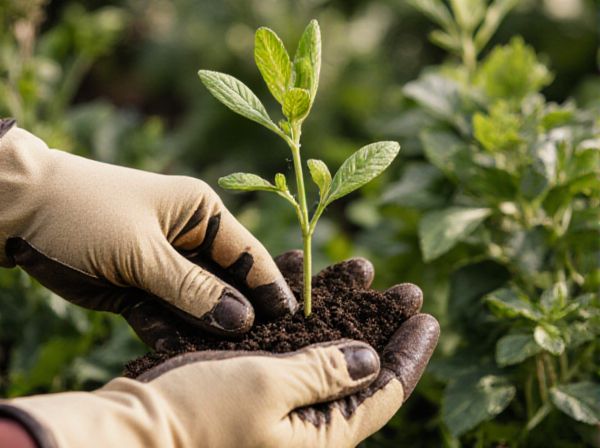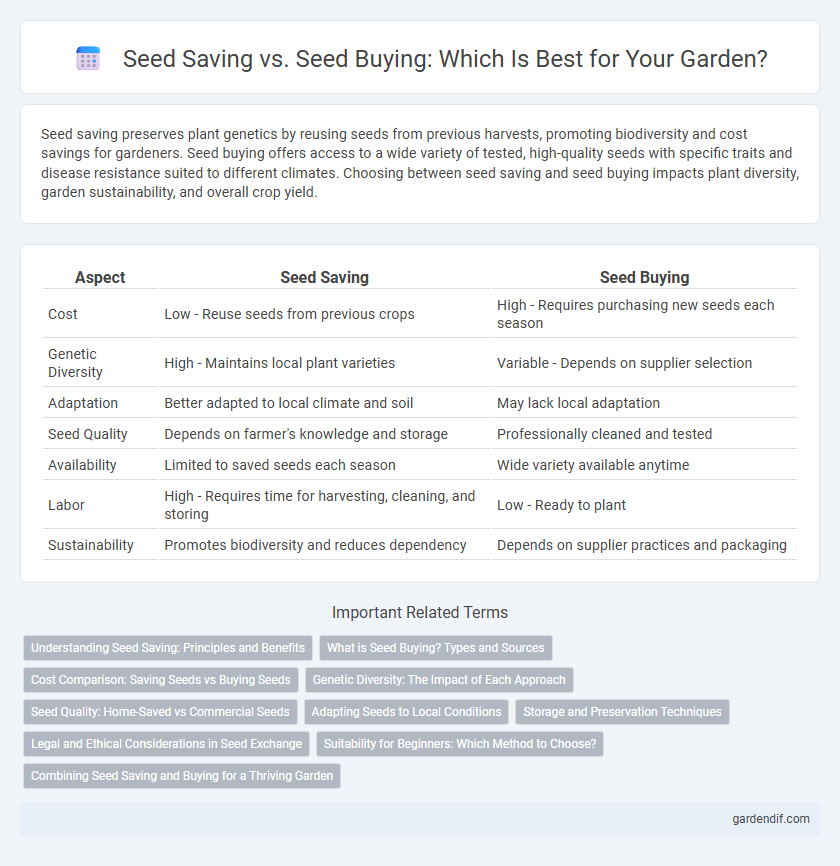
Seed Saving vs Seed Buying Illustration
Seed saving preserves plant genetics by reusing seeds from previous harvests, promoting biodiversity and cost savings for gardeners. Seed buying offers access to a wide variety of tested, high-quality seeds with specific traits and disease resistance suited to different climates. Choosing between seed saving and seed buying impacts plant diversity, garden sustainability, and overall crop yield.
Table of Comparison
| Aspect | Seed Saving | Seed Buying |
|---|---|---|
| Cost | Low - Reuse seeds from previous crops | High - Requires purchasing new seeds each season |
| Genetic Diversity | High - Maintains local plant varieties | Variable - Depends on supplier selection |
| Adaptation | Better adapted to local climate and soil | May lack local adaptation |
| Seed Quality | Depends on farmer's knowledge and storage | Professionally cleaned and tested |
| Availability | Limited to saved seeds each season | Wide variety available anytime |
| Labor | High - Requires time for harvesting, cleaning, and storing | Low - Ready to plant |
| Sustainability | Promotes biodiversity and reduces dependency | Depends on supplier practices and packaging |
Understanding Seed Saving: Principles and Benefits
Understanding seed saving involves selecting healthy, mature seeds from open-pollinated or heirloom plant varieties to preserve genetic diversity and ensure plant adaptability. This practice reduces dependency on commercial seed purchases, lowers costs, and promotes sustainable agriculture by maintaining biodiversity and local plant traits. Mastery of seed saving techniques enhances crop resilience, supports food security, and fosters environmental stewardship.
What is Seed Buying? Types and Sources
Seed buying involves purchasing seeds from commercial suppliers or local stores to cultivate plants. Common types include hybrid seeds, heirloom seeds, and genetically modified seeds, each offering different traits such as higher yield, disease resistance, or heritage preservation. Popular sources for seed buying range from specialized seed companies and agricultural cooperatives to online seed retailers and garden centers, providing a wide selection tailored to diverse planting needs.
Cost Comparison: Saving Seeds vs Buying Seeds
Saving seeds drastically reduces long-term gardening expenses by eliminating the need for yearly seed purchases, often cutting costs by up to 90%. While initial efforts in seed saving involve time and skill investment, the financial return grows exponentially as saved seeds are replanted season after season. In contrast, buying seeds incurs recurring costs that can accumulate significantly, especially for specialty or hybrid varieties.
Genetic Diversity: The Impact of Each Approach
Seed saving preserves local genetic diversity by allowing plants to adapt to specific environmental conditions, fostering resilience and sustainability in agricultural ecosystems. Seed buying often involves hybrid or commercially produced seeds, which can reduce genetic variation and increase vulnerability to pests and diseases. Maintaining genetic diversity through seed saving supports long-term crop stability and food security.
Seed Quality: Home-Saved vs Commercial Seeds
Home-saved seeds often retain unique genetic traits adapted to local growing conditions, enhancing seed quality through natural selection and environmental compatibility. Commercial seeds typically undergo rigorous quality control, offering high germination rates and disease resistance due to controlled breeding and certification processes. Choosing between home-saved and commercial seeds influences plant vigor, yield consistency, and adaptability, impacting overall garden or crop performance.
Adapting Seeds to Local Conditions
Saving seeds from year to year accelerates adaptation to local soil, climate, and pest conditions, promoting resilient plant varieties tailored to specific environments. In contrast, buying seeds often introduces genetically uniform plants that may lack the local adaptations necessary for optimal growth and yield. Over time, seed saving enhances biodiversity and sustainability by preserving traits suited to evolving microclimates and regional challenges.
Storage and Preservation Techniques
Proper seed saving involves drying seeds to optimal moisture levels of 5-8% and storing them in airtight containers within a cool, dark environment at temperatures below 50degF to maintain viability. Seed buying often provides commercially treated seeds with coatings for pest resistance, but these require specific storage conditions such as refrigeration or moisture control to extend shelf life. Both methods benefit from desiccants and periodic viability testing to ensure successful germination during planting season.
Legal and Ethical Considerations in Seed Exchange
Seed saving preserves heirloom varieties and biodiversity by enabling gardeners to share genetics legally within community seed libraries, adhering to intellectual property laws and plant breeders' rights. Seed buying from commercial suppliers involves licenses and patents that restrict reproduction, ensuring compliance with regulations like the International Union for the Protection of New Varieties of Plants (UPOV) convention. Ethical considerations emphasize respecting farmers' rights, promoting open-access seeds, and supporting sustainable agriculture through transparent seed exchange practices.
Suitability for Beginners: Which Method to Choose?
Seed saving offers beginners an affordable and sustainable way to grow plants by preserving seeds from healthy, mature specimens, promoting adaptation to local conditions. Seed buying provides access to a wide variety of high-quality, disease-resistant, and hybrid seeds, ensuring more consistent germination rates and quicker results for novice gardeners. Choosing between seed saving and buying depends on the gardener's patience, experience, and desire for genetic diversity or convenience in their planting process.
Combining Seed Saving and Buying for a Thriving Garden
Combining seed saving and buying enriches garden biodiversity by preserving heirloom varieties while introducing new, resilient cultivars. Seed saving reduces costs and supports sustainability, whereas purchasing seeds ensures access to disease-resistant and high-yield plants. Integrating both methods optimizes plant health, boosts garden productivity, and promotes ecological balance.
Seed Saving vs Seed Buying Infographic

 gardendif.com
gardendif.com